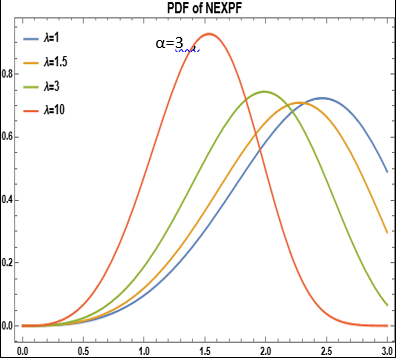Constructing a probability distribution of an extended power function with practical application
Keywords:
the distribution of the power function, The New Exponential-X Power function distribution, the least squares methodAbstract
The process of expanding the probability distributions is one of the important operations that has increased in importance significantly during the past few decades, due to the increase in the ability of classical distributions to represent real data in a broader and more accurate way. In this research, the new exponential family (NEX-Family) was used to build a new probabilistic model called (The New Exponential-X Power function distribution) (NEXPF), and the proposed model is an expansion of the distribution of the power function. As some of its statistical properties were studied, the parameters of the new distribution were estimated in two ways: (the least squares method, the partial estimator’s method). In (Wolfram Mathematica 12.2), several experiments were conducted with small, medium and large sample sizes (100, 75, 50, 25), and the mean square error(MSE)was used to compare the two estimation methods for parameter estimations.
References
أموري هادي كاظم الحسناوي وباسم شليبة مسلم ، (2002) ،"القياس الاقتصادي المتقدم النظرية والتطبيق". قسم الإحصاء – كلية الإدارة والاقتصاد – جامعة بغداد – المكتبة الوطنية، دار الكتب والوثائق ببغداد.
الشمري، نجاة عبد الجبار رجب، (2008)،"استعمال المحاكاة في مقارنة مقدرات التقلص لمعلمة الشكل لتوزيع وايبل لبيانات المراقبة"، أطروحة دكتوراه في علوم الإحصاء، جامعة بغداد – كلية الإدارة والاقتصاد – قسم الإحصاء.
عبد الأحد، عطاف اداور ،(2007)،) تقديرات المعولية للتوزيع الاسي بمعلمتين – دراسة مقارنة (، رسالة ماجستير مقدمة الكلية الإدارة والاقتصاد في جامعة بغداد.
ناجي وليلى مطر، (2015)،"التقدير البيزي لدالة المعولية لتوزيع دالة القوة تحت دوال خسارة مختلفة"، مجلة كلية بغداد للعلوم الاقتصادية، الإصدار: (46)، الصفحات: (195-210).
Ahsanullah, M. (1973). A characterization of the power function distribution. Communications in Statistics-Theory and Methods, 2(3), 259-262.
Al-Babtain, A. A. (2020). A new extended Rayleigh distribution. Journal of King Saud University-Science, 32(5), 2576-2581.
Alzeley, O., Almetwally, E. M., Gemeay, A. M., Alshanbari, H. M., Hafez, E. H., & Abu-Moussa, M. H. (2021). Statistical inference under censored data for the new exponential-X Fréchet distribution: Simulation and application to leukemia data. Computational Intelligence and Neuroscience, 2021.
Draper, N. R., & Smith, H. (1998). Applied regression analysis (Vol. 326). John Wiley & Sons.
Evans, M., Hastings, N., Peacock, B., & Forbes, C. (2011). Statistical distributions. John Wiley & Sons.
Gupta, R. D., & Kundu, D. (2001). Generalized exponential distribution: different method of estimations. Journal of Statistical Computation and Simulation, 69(4), 315-337.
Huo, X., Khosa, S. K., Ahmad, Z., Almaspoor, Z., Ilyas, M., & Aamir, M. (2020). A new lifetime exponential-X family of distributions with applications to reliability data. Mathematical Problems in Engineering, 2020.
Kao, J. H. (1958). Computer methods for estimating Weibull parameters in reliability studies. IRE Transactions on Reliability and Quality Control, 15-22.
Kao, J. H. (1959). A graphical estimation of mixed Weibull parameters in life-testing of electron tubes. Technometrics, 1(4), 389-407.
Meniconi, M., & Barry, D. M. (1996). The power function distribution: A useful and simple distribution to assess electrical component reliability. Microelectronics Reliability, 36(9), 1207-1212.
Mustafa, A., El-Desouky, B. S., & AL-Garash, S. (2016). Weibull generalized exponential distribution. arXiv preprint arXiv:1606.07378.
Okasha, H. M., El-Baz, A. H., Tarabia, A. M. K., & Basheer, A. M. (2017). Extended inverse Weibull distribution with reliability application. Journal of the Egyptian Mathematical Society, 25(3), 343-349.

Downloads
Published
How to Cite
Issue
Section
License
Copyright (c) 2024 College of Administer and Economics - Kerbela University

This work is licensed under a Creative Commons Attribution-NonCommercial-NoDerivatives 4.0 International License.
Authors retain the copyright of their papers without restrictions.



